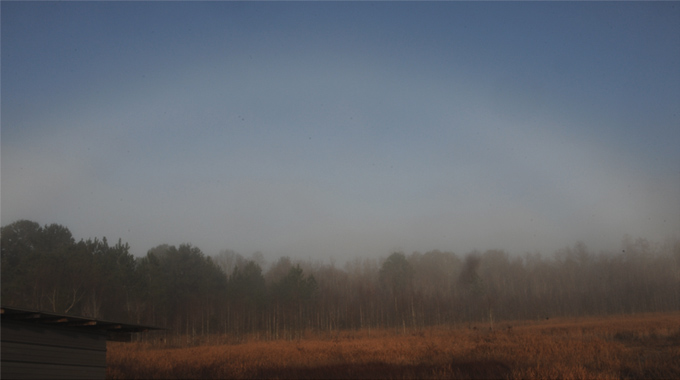Dew Bow
"Dewdrops...are large enough so that the bizarre, hyperbola-shape dewbow seen lying on dewy grass after sunrise shows all the rainbow's colors. The hyperbola results from the flat ground intersecting the 42°-radius cone of the rainbow, the apex of which is at your eye. If the dew lasts well into the day, the dewbow will become a parabola and then an ellipse as the Sun gains altitude." Schaaf

One of the best ways to see a dew bow is in a spider web on a foggy morning. The image above was captured when the sun came out after a cool foggy morning when droplets had condensed on the spider webs in the area. The colors are enhanced in the photo above, but the steps taken to enhance them also contain some elements of the physics of color. The web was about 20cm across and was photographed from a distance of about a meter.

This is the dewbow as photographed. Finding the dewbow involves understanding that a rainbow is formed around the anti-solar point at about 42° and that the conditions are the same for the dewbow. As in searching for a rainbow in a waterfall, you look for the shadow of your head and then position that shadow so that the droplets are out at an angle of 42° from the head shadow. As I positioned my head to see the rainbow colors, they were very subtle - colors that you would notice only if you were looking for them. Since the colored pattern of the rainbow does exhibit some polarization, the colors can be enhanced slightly be using a polarizer on the camera lens. The above photograph was made through a circular polarizer which was rotated to make the rainbow colors slightly more prominent. The moderate enhancement of the colors of the top photograph made use of the fact that much of the light coming from the spider web as reflected and scattered light is essentially white light, or an essentially equal mixture of all visible wavelengths. Increasing the saturation of the light basically has the effect of subtracting out part of the broad-spectrum white light, so will make the colors more evident. The colors in the top photograph were moderately enhanced by increasing the saturation and by removing some emphasis on the brightest and darkest pixels.
|
Index
Rainbow concepts
Atmospheric optics concepts
Reference
Schaaf |


